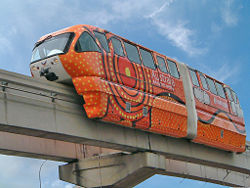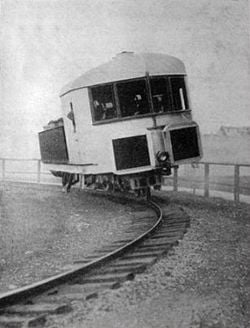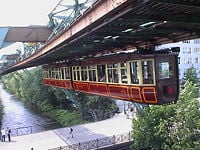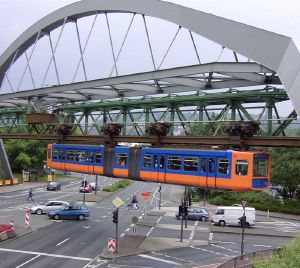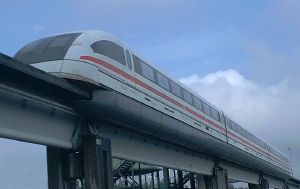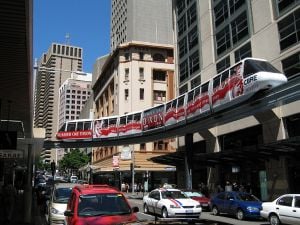Difference between revisions of "Monorail" - New World Encyclopedia
(imported latest version of article from Wikipedia) |
(added credit and category tags, deleted foreign language links) |
||
| Line 108: | Line 108: | ||
*[http://www.lightrailnow.org/facts/fa_monorail003.htm Monorails, Light Rail, and Automated vs. Non-Automated Transit Operation: Comparative Costs in Japan and USA] - a critical article on the cost differences of monorails, whether they are automated or not. From Light Rail Now! | *[http://www.lightrailnow.org/facts/fa_monorail003.htm Monorails, Light Rail, and Automated vs. Non-Automated Transit Operation: Comparative Costs in Japan and USA] - a critical article on the cost differences of monorails, whether they are automated or not. From Light Rail Now! | ||
| − | [[Category: | + | [[Category:Physical sciences]] |
| − | [[Category: | + | [[Category:Transportation technology]] |
| − | + | {{credit|144776755}} | |
| − | |||
| − | |||
| − | |||
| − | |||
| − | |||
| − | |||
| − | |||
| − | |||
| − | |||
| − | |||
| − | |||
| − | |||
| − | |||
| − | |||
| − | |||
| − | |||
| − | |||
| − | |||
| − | |||
Revision as of 04:11, 17 July 2007
A monorail is a single rail serving as a track for a wheeled vehicle; also, a vehicle traveling on such a track.
Background
Attempts at creating unconventional railways have been made since the latter part of the 19th century. Usually these have been claimed to be more efficient, faster or cheaper to construct than conventional railways.
Several attempts have been made to create a system in which a double-flanged steel wheel operates on a single rail similar to the railroad type of rail. The Wuppertal monorail described below is the only surviving monorail of this type.
Monorails have both benefited and suffered from their novelty and concept of modernity. When The Walt Disney Company placed a monorail in their Disneyland theme park in 1959, it exposed large numbers of visitors to the transportation form in a credible though miniature transit setting. At the same time, however, the Disneyland monorail and others built at other Disney properties and amusement locations have tended to identify monorails with amusements rather than practical transportation.
The popular press in the U.S. in the mid 20th century often featured monorail ideas in a "transportation of the future" context, along with images of personal "rocket backpacks" and popular space travel, creating interest but also confusion as to which ideas were fads and which might become reality.
According to Ron Diridon, director of the Mineta Transportation Institute, the real reason monorails in the United States came to be typecast with theme parks and never took flight was because "it got caught in what all mass transportation got caught in in the '50s and '60s — the love affair with the automobile." [1]
Types and technical aspects
Modern monorails depend on a large solid beam as the vehicles' running surface. There are a number of competing designs divided into two broad classes, straddle-beam and suspended monorails.
The most common type of monorail in use today is the straddle-beam monorail, in which the train straddles a reinforced concrete beam in the range of two to three feet (~0.6-0.9 m) wide. A rubber-tired carriage contacts the beam on the top and both sides for traction and to stabilize the vehicle. The straddle-beam style was popularized by the German company ALWEG.
There is also a form of suspended monorail developed by the French company SAFEGE in which the train cars are suspended beneath the wheel carriage. In this design the carriage wheels ride inside the single beam.
Power
Almost all modern monorails are powered by electric motors fed by dual third rails, contact wires or electrified channels attached to or enclosed in their guidance beams. There is a startup called Metrail that has built a hybrid prototype using diesel power to generate electricity for the motors.
Magnetic levitation
Magnetic levitation train (maglev) systems by the German Transrapid were built as straddle-type monorails, as they are highly stable and allow rapid deceleration from great speed. When in full-speed operation maglev trains hover over the track and are thus not in physical contact with it. It is the fastest monorail, running at up to 311 mph (501 km/h).
Switching
Some early monorail systems—notably the suspended monorail of Wuppertal (Germany), dating from 1901 and still in operation—have a design that makes it difficult to switch from one line to another. Some other monorail systems avoid switching as much as possible, by operating in a continuous loop or between two fixed stations, as in Seattle, Washington.
Current operating monorails are capable of more efficient switching than in the past. In the case of suspended monorails, switching may be accomplished by moving flanges inside the beamway to shift trains to one line or another.
Straddle-beam monorails require that the beam structure itself be moved to accomplish switching, which originally was an almost prohibitively ponderous procedure. Now, however, the most common way of achieving this is to place a moving apparatus on top of a sturdy platform capable of bearing the weight of vehicles, beams and its own mechanism. Multiple-segmented beams move into place on rollers to smoothly align one beam with another to send the train in its desired direction, with the design originally developed by ALWEG capable of completing a switch in 12 seconds[1]. Some of these beam turnouts are quite elaborate, capable of switching between several beams or even simulating a railroad double-crossover.
In cases where it must be possible to move a monorail train from one beam to any of a number of other beams, as in storage or repair shops, a traveling beam not unlike a railroad transfer table may be employed. A single beam, at least long enough to carry a single monorail vehicle, is aligned at an entry beam to be mounted by the monorail cars. The entire beam then rolls with the vehicle to align with the desired storage beam.
Systems similar in appearance
The term 'monorail' is often applied by members of the public to any modern elevated railway, particularly automated ones such as the Docklands Light Railway, Vancouver SkyTrain and the JFK AirTrain, but this usage is erroneous; these systems use the same twin rails and electric third rail as most underground metros and some main-line railways.
Advantages and disadvantages
Advantages
- The primary advantage of monorails over conventional rail systems is that they require minimal space, both horizontally and vertically. Monorail vehicles are wider than the beam, and monorail systems are commonly elevated, requiring only a minimal footprint for support pillars.
- Due to a smaller footprint they are seen as more attractive than conventional elevated rail lines and block only a minimal amount of sky.
- They are quieter, as modern monorails use rubber wheels on a concrete track (though some non-monorail subway systems, like certain lines of the Paris Métro and all of the Montreal metro, use the same technique and are equally quiet)
- Monorails are capable of climbing and descending steeper grades than heavy or light rail systems.[citation needed]
- Unlike conventional rail systems, straddle monorails wrap around their track and are thus not physically capable of derailing, unless the track itself suffers a catastrophic failure, which is why monorails have an excellent safety record.
Disadvantages
- In an emergency, passengers may not be able to immediately exit because the monorail vehicle is high above ground and not all systems have emergency walkways. The passengers must sometimes wait until a rescue train, fire engine or a cherry picker comes to the rescue. Newer monorail systems resolve this by building emergency walkways alongside the entire track, at the expense of visual intrusion. Suspended railways resolve this by building aircraft style evacuation slides into the vehicles. Japanese systems use the next train to tow broken down trains to the next station, but this has yet to occur.
- Adding extensions by diverging the track is more expensive because of the linear nature of the track itself.
Monorail systems
- Main article: List of monorail systems
ReferencesISBN links support NWE through referral fees
- ↑ The Switch Myth. Retrieved 2007-01-15.
See also
- Louis Brennan
- Pod Monorail
- Public transport
- Personal rapid transit
- Transrapid
- Meigs Elevated Railway, an experimental monorail from 1886
- Gyro Monorail
- Monorail history
- Slope car
- Marge vs. the Monorail - The Simpsons episode satirizing monorail development
- Transport Tycoon - a transport game that has monorails and a maglev system.
- Railroad
External links
Monorails in general
- The Monorail Society - home page of a volunteer organization promoting monorails, with separate pages on monorail switches and a backyard monorail
- Innovative Transportation Technologies - a website for the Transportation engineering and Urban planning programs at the University of Washington
Specific monorails
- Schwebebahn Monorail in Wuppertal, Germany
- Las Vegas Monorail
- Seattle Monorail - separately managed from the new Seattle Monorail Project (see also Seattle Monorail Blog)
- Sydney Metro - partly a monorail system
- Maglev Monorail - International Maglev Board
- Niles Monorail - Amateur built
- Walt Disney World's Monorail system
- nywf64.com (1964/1965 New York World's Fair Website) story of the AMF Monorail
Monorail advocacy groups
- Austin Monorail Project - a non-profit advocating monorail transit for Austin, TX
- 2045 Seattle - a grassroots movement that supports the construction of rapid transit monorail in Seattle, WA
- The Monorail Society - an all-volunteer organization founded to foster more awareness and promote this unique method of transportation
Organizations/views opposing monorails
- Las Vegas Monorail: Troublesome Technology in a Unique "Niche" Application - a critical article on the Las Vegas Monorail from Light Rail Now!, a pro-light rail organization in Austin, TX opposed to monorails
- Monorail Capital Costs: Reality Check - a critical article on the capitial costs of monorails. From Light Rail Now!
- Monorails, Light Rail, and Automated vs. Non-Automated Transit Operation: Comparative Costs in Japan and USA - a critical article on the cost differences of monorails, whether they are automated or not. From Light Rail Now!
Credits
New World Encyclopedia writers and editors rewrote and completed the Wikipedia article in accordance with New World Encyclopedia standards. This article abides by terms of the Creative Commons CC-by-sa 3.0 License (CC-by-sa), which may be used and disseminated with proper attribution. Credit is due under the terms of this license that can reference both the New World Encyclopedia contributors and the selfless volunteer contributors of the Wikimedia Foundation. To cite this article click here for a list of acceptable citing formats.The history of earlier contributions by wikipedians is accessible to researchers here:
The history of this article since it was imported to New World Encyclopedia:
Note: Some restrictions may apply to use of individual images which are separately licensed.
